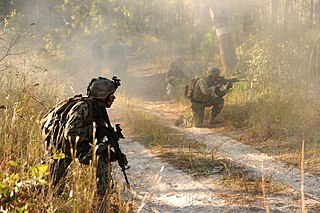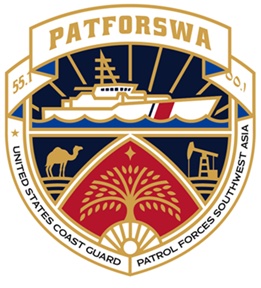
The United States Navy Sea, Air, and Land (SEAL) Teams, commonly known as Navy SEALs, are the United States Navy's primary special operations force and a component of the United States Naval Special Warfare Command. Among the SEALs' main functions are conducting small-unit special operation missions in maritime, jungle, urban, arctic, mountainous, and desert environments. SEALs are typically ordered to capture or kill high-level targets, or to gather intelligence behind enemy lines. SEAL team personnel are hand-selected, highly trained, and possess a high degree of proficiency in unconventional warfare (UW), direct action (DA), and special reconnaissance (SR), among other tasks like sabotage, demolition, intelligence gathering, and hydrographic reconnaissance, training, and advising friendly militaries or other forces. All active SEALs are members of the U.S. Navy.

A Marine Expeditionary Unit is the smallest air-ground task force (MAGTF) in the United States Fleet Marine Force. Each MEU is an expeditionary rapid reaction force ready to answer any crisis, whether it be disaster aid or a combat mission. Marine Amphibious Unit (MAU) was the name used until the late 1980s.

The Fifth Fleet is a numbered fleet of the United States Navy. Its area of responsibility encompasses approximately 2.5 million square miles, and includes the Persian Gulf, Red Sea, Arabian Sea, and parts of the Indian Ocean. It shares a commander and headquarters with U.S. Naval Forces Central Command (NAVCENT) in Bahrain. Fifth Fleet/NAVCENT is a component command of, and reports to, U.S. Central Command (CENTCOM).

United States Navy Explosive Ordnance Disposal technicians render safe all types of ordnance, including improvised, chemical, biological, and nuclear. They perform land and underwater location, identification, render-safe, and recovery of foreign and domestic ordnance. They conduct demolition of hazardous munitions, pyrotechnics, and retrograde explosives using detonation and burning techniques. They forward deploy and fully integrate with the various Combatant Commanders, Special Operations Forces (SOF), and various warfare units within the Navy, Marine Corps, Air Force and Army. They are also called upon to support military and civilian law enforcement agencies, as well as the Secret Service.

U.S. Coast Guard Port Security Units are Deployable Specialized Forces organized for sustained expeditionary security and anti-terrorism. They provide Anti-Terrorism Force Protection (ATFP) missions, which include harbor and port defense, protection of High Value Assets (HVAs), expeditionary security, Sea Lines of Communications (SLOCs), special missions. and coastal surveillance. PSUs are expeditionary units that conduct OCONUS missions in support of a requesting regional combatant commander. PSUs usually operate under the direction of the Coast Guard's Pacific Area (PACAREA) command but are unique in that they are the only Coast Guard units that can be quickly requested by the Department of Defense.

The EXW qualification is a warfare qualification awarded to enlisted United States Navy personnel assigned to U.S. Navy expeditionary combat units, who satisfactorily complete the required qualification course and pass a qualification board hearing. The program was approved July 31, 2006 by then-Chief of Naval Operations Adm. Michael Mullen.

The United States Marine Corps is organized within the Department of the Navy, which is led by the Secretary of the Navy (SECNAV). The most senior Marine commissioned officer is the Commandant of the Marine Corps, responsible for organizing, recruiting, training, and equipping the Marine Corps so that it is ready for operation under the command of the unified combatant commanders. The Marine Corps is organized into four principal subdivisions: Headquarters Marine Corps, the Operating Forces, the Supporting Establishment, and the Marine Forces Reserve.

The Navy Expeditionary Combat Command (NECC) is an echelon III command of the United States Navy, which serves as the single functional command to centrally manage current and future readiness, resources, manning, training and equipping of the United States Navy's 21,000 expeditionary forces who are currently serving in every theater of operation. The NECC was established in January 2006. NECC is a subordinate command of the Navy's Fleet Forces Command.
The structure of the United States Navy consists of four main bodies: the Office of the Secretary of the Navy, the Office of the Chief of Naval Operations, the operating forces, and the Shore Establishment.

The Naval Coastal Warfare Community is a component of the United States Navy, part of the Navy Expeditionary Combat Command (NECC). The Navy's Maritime Expeditionary Security Force (MESF) is the main combat unit assigned to Naval Coastal Warfare (NCW).
The Riverine Squadrons of the United States Navy are elements of the Navy's Navy Expeditionary Combat Command (NECC). According to the Navy: “The Navy’s Riverine force focuses on conducting Maritime Security Operations and Theater Security Cooperation in a riverine area of operations or other suitable area. The force is capable of combating enemy riverine forces by direct fire, or by coordinating supporting fire. It will share battle space with the other Services in an effort to close the seams in Doctrine, Tactics, Techniques, and Procedures, and Command, Control, Communications, Computers, Intelligence, Surveillance and Reconnaissance.”

The Marine Corps Security Force Regiment is a dedicated expeditionary security and anti-terrorism regiment of the United States Marine Corps. Its mission is to provide security forces to guard high-value naval installations, most notably those containing nuclear vessels and weapons. Additionally, it also provides the Fleet Anti-terrorism Security Teams (FAST) and Recapture Tactics Teams (RTT). Marines who complete Security Forces training are assigned a secondary Military Occupational Specialty (MOS) of 8152, while instructors can earn 8153.

Helicopter Sea Combat Squadron 25 (HSC-25) "Island Knights" is a United States Navy helicopter squadron based at Andersen Air Force Base, Guam. The "Island Knights" of HSC-25 fly the MH-60S "Knighthawk" helicopter, manufactured by Sikorsky Aircraft Corporation in Stratford, Connecticut.

A Maritime Special Purpose Force (MSPF) is a United States Marine Corps specialized sub-unit of a Marine expeditionary unit. A MSPF is deployed to give the commanders low profile, two-platoon surgical emplacement in the accessible littoral regions. The MSPF provides the enhanced operational capability and precision skills to complement, enable, and execute selected conventional, maritime special operations. They can also perform operations not resident in traditional amphibious raid companies.

The Commander, Naval Air Force Atlantic is the aviation Type Commander (TYCOM) for the United States Naval aviation units operating primarily in the Atlantic under United States Fleet Forces Command. Type Commanders are in administrative control (ADCON), and in some cases operational control (OPCON) of certain types of assets assigned to the Pacific and Atlantic Fleets. AIRLANT is responsible for the material readiness, administration, training, and inspection of units/squadrons under their command, and for providing operationally ready air squadrons and aircraft carriers to the fleet.

Patrol Forces Southwest Asia (PATFORSWA) is a United States Coast Guard command based in Manama, Bahrain. PATFORSWA was created in November 2002 as a contingency operation to support the U.S. Navy with patrol boats. The command's mission is to train, equip, deploy, and support combat-ready Coast Guard forces conducting operations in support of Operation Iraqi Freedom (OIF), Operation Enduring Freedom (OEF), Operation Inherent Resolve (OIR) in the Naval Forces Central Command's area of responsibility. It was commissioned as a permanent duty station in June 2004. In July 2003, PATFORSWA moved from its own compound to facilities at Naval Support Activity Bahrain.

Joint Base Charleston is a United States military facility located partly in the city of North Charleston, South Carolina and partly in the city of Goose Creek, South Carolina. The facility is under the jurisdiction of the United States Air Force 628th Air Base Wing, Air Mobility Command (AMC).
The Coastal Riverine Force (CORIVFOR) was a unit of the United States Navy within the organizational structure of the Navy's Navy Expeditionary Combat Command (NECC). The unit was established following the merger of Riverine Group 1 and the Maritime Expeditionary Security Group 1 & 2 on June 1, 2012. Its express purpose is to provide port and harbor security, and offshore protection for maritime infrastructure and Military Sealift Command ships operating in coastal waterways.

















